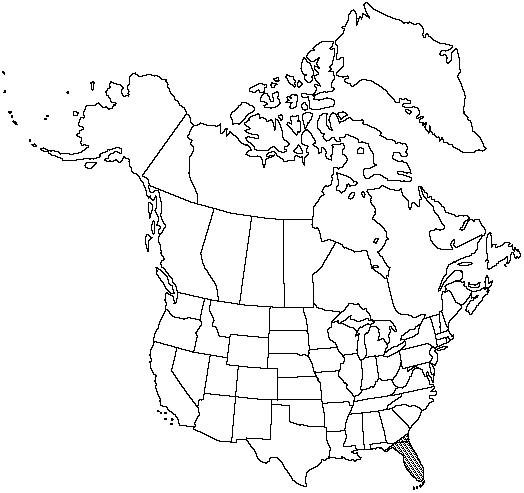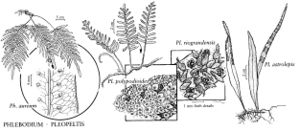Phlebodium aureum
J. Bot. (Hooker) 4: 59. 1841.
Stems creeping, ca. 8–15 (–30) mm diam., densely scaly; scales reddish to golden, long-attenuate, 10–20 mm. Leaves bright green or glaucous, arching to pendent, scattered, 3–13 dm. Petiole 1.5–5 dm, smooth, with a few scales near base. Blade pinnately and deeply lobed, 3–8 × 1–5 dm, glabrous, terminal segment conform. Segments lanceolate to elliptic, or linear-lanceolate to linear, 6–20 × 1–4 cm, margins entire or sometimes undulate. Sori in 1 line on each side of costae, occasionally 2d row present, sori terminal or at junction of free included veinlets. 2n = 148.
Habitat: Epiphytic on a variety of trees or on logs, dense piles of humus, but most commonly among old leaf bases of Sabal palmetto Loddiges, in various habitats from hammocks to swamps
Elevation: 0 m
Distribution

Fla., Ga., Mexico, West Indies, Central America, South America
Discussion
Phlebodium aureum occurs north to Dixie and Nassau counties in Florida, and it is disjunct in Franklin County. It is also found in Georgia (W. H. Duncan 1954; L. H. Snyder Jr. and J. G. Bruce 1986). Two varieties (or subspecies) have been recognized, Phlebodium aureum var. aureum and P. aureum var. areolatum (Humboldt & Bonpland ex Willdenow) Farwell. The latter is now often elevated to species rank and given the name P. pseudoaureum (Cavanilles) Lellinger. Phlebodium pseudoaureum is widespread in Central America and South America (D. B. Lellinger 1987) and has been reported as rare in Florida by G. R. Proctor (1985). I have not seen specimens that could be convincingly referred to P. pseudoaureum.
Phlebodium aureum, a tetraploid species, is believed to have arisen through allopolyploidy following hybridization between P. pseudoaureum and P. decumanum (Willdenow) J. Smith, a widespread species in tropical America.
Selected References
None.
Lower Taxa
"dm" is not declared as a valid unit of measurement for this property."dm" is not declared as a valid unit of measurement for this property."dm" is not declared as a valid unit of measurement for this property."dm" is not declared as a valid unit of measurement for this property.
